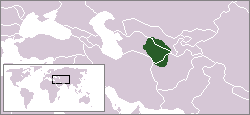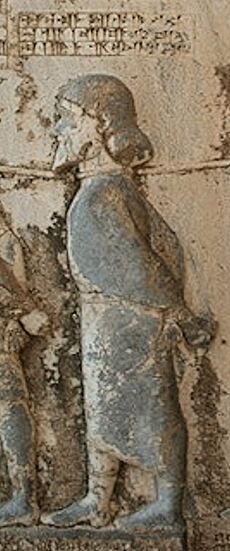Margiana facts for kids
Quick facts for kids Margiana
Marv
|
|
|---|---|
| Province of the Seleucid Empire, Parthian Empire and Sasanian Empire | |
| c. 281–261 BC–651 AD | |
 Margiana, ca. 300 BC |
|
| Capital | Merv |
| Historical era | Antiquity |
|
• Established
|
c. 281–261 BC |
|
• Annexed by the Rashidun Caliphate
|
651 AD |
| Today part of | Afghanistan Turkmenistan Uzbekistan |
Margiana (Greek: Μαργιανή Margianḗ, Old Persian: Marguš, Middle Persian: Marv) was an important historical area. It was centered around the Merv oasis. This region was a small part of the Achaemenid Empire and later a province in the Seleucid Empire, Parthian Empire, and Sasanian Empire.
Margiana was located in the valley of the Murghab River. This river starts in the mountains of Afghanistan. It flows through modern Afghanistan and then reaches the Merv oasis in Turkmenistan. Margiana shared borders with Parthia to the southwest and Aria to the south. It also bordered Bactria in the east and Sogdia in the north.
Contents
History of Margiana
Early Times
Historians are not completely sure about Margiana's history before the Achaemenid conquest. It was part of a Bronze Age civilization. This civilization is called the Bactria–Margiana Archaeological Complex (BMAC). Some experts think a kingdom and cities started here. Others believe it was part of a larger Iranian state. This state might have controlled areas like Aria and Sogdia. However, it is known that advanced ways to water crops began in the 7th century BC. Margiana might have also been part of Bactria under the Median Empire.
Persian Rule

The Persian king Cyrus the Great took control of Margiana. This happened between 545 and 539 BC. It remained part of the Bactria region. Cyrus also founded the city of Merv. After Darius the Great won against a false king named Gaumata in 522 BC, many revolts broke out.
A revolt in Margiana was led by a man named Frâda. It was quickly stopped in December 521 BC. Dadarsi, the governor of Bactria, put down the rebellion. An old text says that over 55,000 Margians were killed. Also, nearly 7,000 were captured after the revolt. Later, Margiana became a separate region. It was joined with the area of Aria.
Alexander the Great and His Generals
After the Battle of Gaugamela in 331 BC, Alexander the Great defeated Darius III. Darius III ran away towards Bactria. But he was overthrown by Bessus, the governor of Bactria. Bessus continued fleeing east through Aria and Margiana. Alexander then surprised Bessus by attacking through different routes. He crossed the Hindu Kush mountains in 329 BC. Bessus fled north to Sogdia. There, he was betrayed and given to Alexander.
In July 329 BC, Alexander built a city called Alexandria Eschate. It was on Sogdia's northern border. At the same time, Spitamenes led a revolt. He surrounded the Sogdian capital, Maracanda. Alexander defeated a group called the Scythians. Then he marched to help Maracanda. Spitamenes moved south and attacked Balkh.
In 328 BC, Alexander sent his general Craterus to make Margiana stronger. Craterus built a fort in Merv. He also rebuilt the city and named it Alexandria in Margiana. Another general, Coenus, defeated Spitamenes. This happened in December 328 BC. The next year, Sogdia joined Bactria. They formed one region under a ruler named Philip.
Hellenistic Period
After Alexander's death in 323 BC, his generals divided his empire. Philip might have stayed as governor of Bactria. But in 321 BC, Stasanor replaced him. Stasanor stayed neutral during the wars between the generals. Later, Margiana came under the control of Seleucus I Nicator.
Around 280 BC, nomadic tribes called the Parni attacked Margiana. Several cities were destroyed. Seleucus sent his general Demodamas to fight them off. Seleucus's son, Antiochus I Soter, built a huge wall around the Merv oasis. It was over 300 km long. He rebuilt the city and renamed it Antiochia in Margiana. This became the capital of a new region. It helped protect trade routes from Mesopotamia to the far east.
Diodotus I, the governor of Bactria, defended Margiana. He stopped a Parni invasion around 239 BC. This showed that the Seleucid king could not protect his eastern lands. So, Diodotus declared himself king. This created the Greco-Bactrian Kingdom.
Parthian and Sasanian Rule
The Parthians took over Margiana around 170 BC. This was under Mithridates I of Parthia. A group called the Yuezhi moved west. This caused other groups, the Saka, to move into Sogdia and Bactria. Around 140 BC, the Saka invaded Parthian lands through Margiana. They caused trouble for the Parthians until 124 BC. They even killed two Parthian kings.
The Yuezhi settled in Sogdia. They controlled Margiana until 115 BC. Then Mithridates II of Parthia took back control. He forced the Yuezhi to move south into Bactria. In 53 BC, 10,000 Roman prisoners were settled in Antiochia in Margiana. They were captured by the Parthians after a battle. The Yuezhi later formed the Kushan Empire.
The Kushans returned to Margiana in the 1st century AD. They helped a local ruler named Sanabares become king. He ruled from about 50 AD to 65 AD. By the early 3rd century AD, Margiana was a state that paid tribute to the Parthian Empire. But it was almost independent.
After Ardashir I defeated the last Parthian king in 224 AD, Margiana submitted to him. It was ruled by a king named Ardashir. Margiana was allowed to make its own coins for a while. But Shapur I fully took over around 260 AD. He gave control of Margiana to his son, Narseh.
In the fifth century, a group called the Hephthalites (White Huns) invaded Margiana. King Bahram V of the Sasanian Empire fought them. He tricked them and attacked their camp. Bahram chased them to the Oxus River in Margiana. His general greatly weakened them. However, the Hephthalites returned around 480 AD. They occupied Margiana until 565 AD.
End of an Era
In 642 AD, the Sasanian Empire suffered a big defeat. This was at the hands of the Rashidun Caliphate. The last Sasanian king, Yazdegerd III, fled east. He arrived in Margiana in 651 AD. The local governor, Mahoe Suri, welcomed him. But Yazdegerd tried to replace Mahoe. Mahoe refused and plotted with the Hephthalite ruler Nezak Tarkan. Yazdegerd found out and fled.
As the Muslim army came closer, Mahoe agreed to pay them tribute. The Muslim general Ahnaf ibn Qais began to spread Islam in Margiana. Ahnaf captured a city called Merw i-Rud. This forced Yazdegerd to flee to Balkh. The Caliph ordered Ahnaf to stay at Merv. But Yazdegerd formed an alliance with the Hephthalites. He then approached Merv. Ahnaf gathered his forces and defeated Yazdegerd at the Battle of Oxus River. After his defeat, the Sasanian king hid in a mill. A local miller killed him there. This brought an end to the Sasanian Empire.
Religion in Margiana
Margiana was on the Silk Road. This meant many different religions were practiced there before the Islamic conquest. Most people followed Zoroastrianism. But there were also communities of Buddhist, Christian, Manichaean, and Jewish people.
Buddhist monasteries were known to exist in Margiana. The city of Merv was a major center for Buddhist learning. A Manichaean community was present from the mid-3rd century AD.
According to a historian named Al-Biruni, Christianity reached Margiana within 200 years of Christ's birth. At least one Christian monastery was built in the 3rd century AD. A Christian area called a diocese was mentioned in Merv in 334 AD. A Nestorian diocese existed in Merv from 424 AD. It later became a larger church region in 554. The first recorded bishop of Merv was named Bar Shaba. His name means "son of the deportation." This suggests that Christians in Margiana might have been moved from Roman lands. Another diocese also existed in southern Margiana in 554.
See also
Sources

